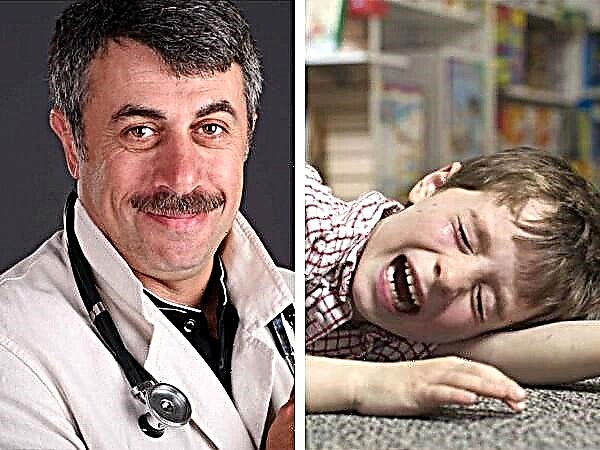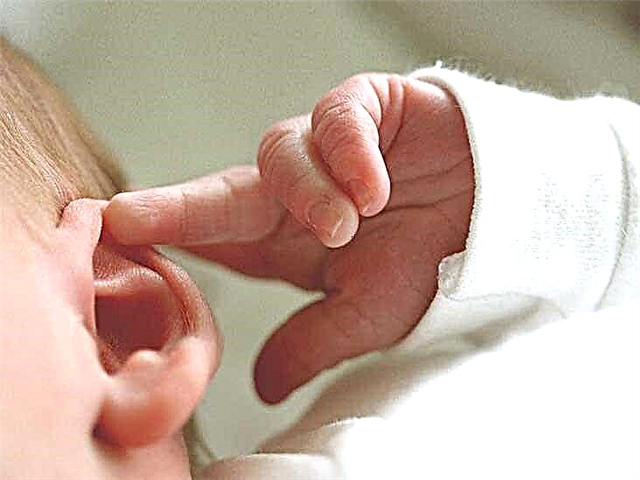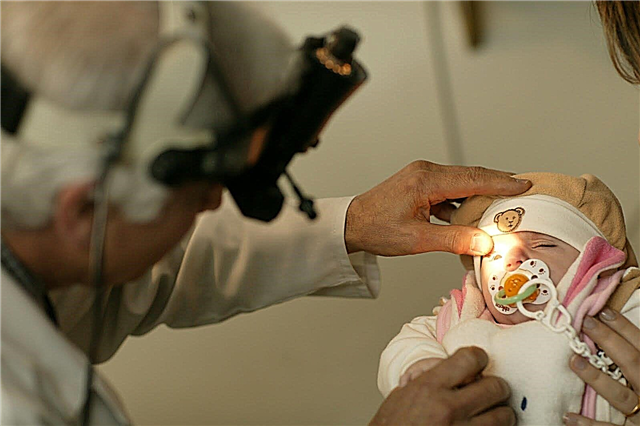Ideal temperature in a newborn's room
As evidenced by the analysis of pediatric sources, the optimal temperature parameters for the room in which the newborn child is located are in the range of 18 - 20 ° C. In this case, all biochemical processes in the child's body will proceed completely naturally, without any failures.
Television doctor E.O. Komarovsky is convinced that the higher the temperature in the nursery, the worse for the child. Overheating of children is no less, and even significantly more dangerous than hypothermia. It is extremely important to remember this for every parent.
To control the parameters of the air in the room, the thermometer should be placed next to the newborn's cradle, and the hygrometer (a device that determines the humidity in the room) should be placed away from all heating devices.

Regardless of the available recommended air indicators in the apartment, parents should, first of all, focus on children's well-being. That is, the temperature in the room should "like" the baby, should correspond to the characteristics of his body.
If the temperature in the room is within normal limits, but the child's lower and upper extremities become cold, socks and additional clothing should be put on. If the newborn is sweating and blushing, it should be unraveled.
For an infant who was born earlier than the due date, it is necessary to create special conditions due to insufficient thermoregulation processes. Therefore, the temperature in the premature baby room will be above 20 ° C.
Air humidity
Room air humidity is another important indicator of the environment for a newborn. The air exhaled by a child is 100% humidity and high temperature. If the environment is too dry, the child's body wastes fluid to humidify the air, which leads to a rapid loss of moisture.
A comfortable indicator of humidity, which should be in a house with a newborn child, is 50 - 70%. Approximately this level is observed in the off-season with regular ventilation and the central heating turned off.
But since the body of each newborn is individual, to understand whether the humidity level corresponds to optimal values, one should focus on the baby's health, his well-being.
Favorable signs are:
- good dream;
- normal body temperature;
- natural skin color;
- absence of rash and other irritations;
- dryness and warmth of the limbs;
- even breathing.
It should be understood that in winter, during the period of increased battery operation, the air in the apartment is not humid enough. Measurements with a hygrometer show that the indicators are reduced by several times.
Danger of hypothermia and overheating
A newborn child sleeps about 20 hours a day, the rest of the time he either eats, or participates in organizational moments arranged by the parents. Naturally, he is not able to dress or undress on his own.
His metabolism takes place in a higher mode than that of mom or dad. At the same time, thermoregulation has not yet been set and adjusted, which is why it is so important to know what temperature should be in the nursery in order to avoid overheating and freezing of the child.
Overheat
Knowing about the imperfection of thermoregulation, adults are afraid to "freeze" a newborn baby. Hence the constant wrapping up in warm clothes and the use of numerous diapers. At the same time, parents forget that overheating is a particular danger to the child's body.

The metabolism of a newborn is quite active, accompanied by the release of a large volume of heat. The child's body needs to "dump" this warmth. This process is in progress using two ways:
- through the lungs;
- through the skin (sweat evaporates).
In the first case, the air that is inhaled by the child, passing through the lungs, begins to heat up to body temperature. In this case, a certain amount of heat will be lost.
The cooler the room, the higher the heat loss. If the temperature regime is excessively higher than normal, then the heat release begins to decrease significantly. Consequently, overheating of a still imperfect organism may occur.
If the first way of temperature regulation is not possible, the newborn activates the second way - through the skin. That is, the child sweats, excess heat is released, but at the same time there is a loss of moisture and salts.
Thus, the increased temperature and humidity in the room can lead to dehydration of the child's body, which is fraught with a deterioration in overall health.
The main signs of overheating are:
- excessive moisture in the skin;
- diaper rash;
- insomnia;
- sweating;
- pain in the tummy, bloating;
- thrush in the mouth;
- decreased appetite;
- Difficulty breathing through the nose
- lower heart rate;
- retraction of the fontanelle.
The most serious negative consequences that threaten the life of a child are considered a jump in children's temperature, the release of blood from the nasal cavity, and the rolling of the pupils. With such symptoms, you should urgently call an ambulance.
Overheating lies in wait for the baby not only at home, but also on the street. Try not to walk with the newborn in the heat, go for a walk only in the early morning and late evening. Also, avoid direct rays of the sun, which often provoke sunstroke.
Hypothermia
A child can become overcooled not only at low temperatures in the apartment, but also in case of overwork or insufficient nutrition. The kid also freezes in cool water, or in wet clothes.
 Signs of hypothermia in a newborn are:
Signs of hypothermia in a newborn are:
- pale skin;
- cold limbs;
- shiver;
- hiccuping;
- cold sweat;
- slow movements of the arms and legs;
- rapid breathing.
In extreme cases, the nasolabial triangle may turn blue and even faint. To avoid negative consequences, an urgent need to stabilize the body temperature of the child.
Otherwise, the development of such undesirable and even dangerous for children's health is possible. states like:
- general depletion of the child's body;
- cold (in case of chronic hypothermia, pneumonia is possible);
- brain damage;
- changes in the cardiovascular system;
- frostbite of the hands or feet.
Parents should immediately start raising their body temperature. First of all, it is worth checking if the newborn child is wet or sweaty. If the suspicions are confirmed, the baby needs to be changed into dry linen and well wrapped.
Danger of low humidity
Low moisture content in room air negatively affects the well-being of all newborn babies. Parents often do not notice lowered indicators of this parameter, however, the child reacts sharply to any discomfort.
The reduced level of moisture in the room leads to a sharp dusting of the air, an increase in the number of pathogens and allergens. The most common results of dehydration are various negative conditions:
- asthma. When the body is dehydrated, parts of the lungs can be damaged, as a result of which chronic inflammation of the respiratory system develops;
- allergic diseases. In case of a lack of moisture in the body, the level of histamines in the circulatory system rises. An allergy occurs, which can manifest itself as a rash, rhinitis, itching sensations;
- dry skin. Dehydration damages the top layers of the skin, resulting in dry patches on the baby's body;
- dryness in the mouth and nose. Due to low humidity, the airways dry out. Dry crusts form in the nasal cavity, the child begins to cough;
- thickening of the blood. The volume of fluid decreases, the blood begins to thicken, which is extremely dangerous for the entire child's body.
Thus, it is extremely important for a baby to be in a room with an optimal level of humidity. This is not just a whim, but an essential condition for the normal development of children. Be sure to remember this!
Ideal temperature and humidity: creating optimal conditions
Comfortable humidity and air temperature in the room of a small newborn must be created correctly, focusing on the season. So, in the summer, an air conditioner can be installed to regulate the air parameters. It is only important not to direct cold streams directly to the crib.
The temperature in both the nursery and the adult room depends on the start of the heating season. If it has not come yet, and it is cold in the house, parents are advised to purchase a heater. In winter, it is extremely difficult to follow the norms, as the premises become excessively hot and "dry out".
In order for the temperature standards to be in order, experts advise adhering to certain recommendations, which should be described in more detail.
Ventilation of the room
 Fresh air is extremely useful for any child, therefore it is necessary to ventilate the room every four hours.
Fresh air is extremely useful for any child, therefore it is necessary to ventilate the room every four hours.
The optimal humidity and temperature for sleeping is especially important, otherwise it will be impossible for the baby to be rocked and put to sleep normally.
When airing the nursery, the newborn must be taken to another room.
This helps not only to optimize temperature and humidity conditions, but also to saturate the room with oxygen. Another option is to go for a walk with your child.
Battery closure
If the central heating radiators are too hot, and it is impossible to reduce the heating level, it is recommended to cover them with special wooden or plastic shields. You can also hang a thick cloth over the batteries.
Getting rid of canopies
A canopy bed is a very cute and aesthetically pleasing structure. However, beautiful curtains can restrict your baby's oxygen supply, leading to a rise in body temperature. To ensure a free flow of air, it is best to get rid of the canopy or remove it while the baby is sleeping.
Carpets are a well-known dust collector, it is also better to refuse them. In addition, it is worth getting rid of excess furniture, since blockages also disrupt the normal air circulation in the room.
Choosing the right clothes
The correct selection of clothes and bedding is important for the child. It is important to stop wearing synthetic products by newborns. In them, the skin does not breathe, therefore, there is a violation of the thermal regulation of the baby's body. It is generally better to refuse a hat.
In addition, you should not wrap up the baby if it is hot in the room, and expose him if the room temperature is low. Well, things made from natural fabrics will help create optimal conditions for restful sleep and active wakefulness.
More frequent feeding
 If the newborn baby is too hot, shortening the intervals between meals may help.
If the newborn baby is too hot, shortening the intervals between meals may help.
Breast milk is known to contain 80% water, which means that breastfeeding quenches thirst and optimizes fluid levels in the body.
If the baby feeds on an artificial mixture, you can add water to it with a bottle between meals.
It is important to keep the liquid at room temperature.
Washing
In summer, it is extremely difficult to provide optimal conditions, the child is hot and dry. In this case, you need to bathe the baby up to three times a day, but not for the purpose of cleanliness, but to improve well-being. Naturally, there is no need to use detergents.
Increasing humidity
As already noted, humidified air is no less important for a newborn than an optimal temperature regime. You can create comfortable conditions with the help of technical devices or improvised means.
Specialists advise:
- install a special air humidifier;
- carry out wet cleaning of the room more often;
- place containers with water, fountains next to a child or batteries;
- spray water using "spray";
- cover radiators with wet towels or sheets.
The air temperature in a newborn baby's room is an important condition for well-being, health and emotional well-being. Do not forget to monitor the state of the environment, and the baby will develop without any problems for the delight of parents.



